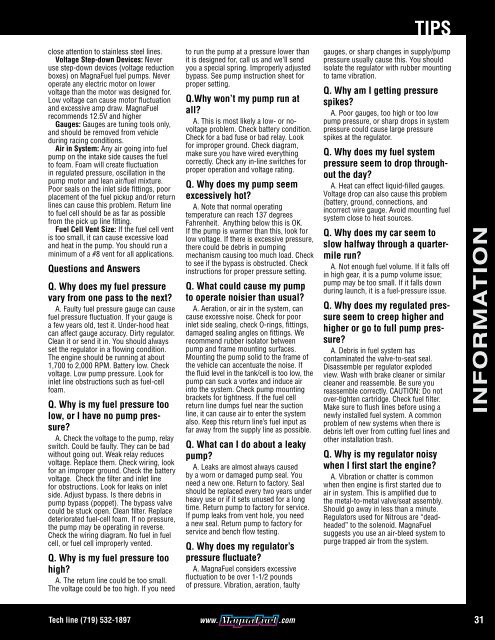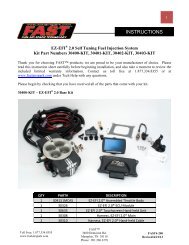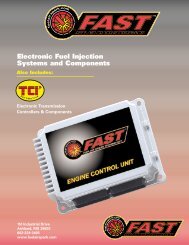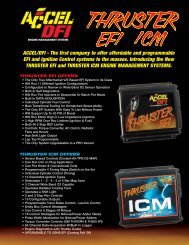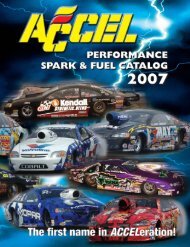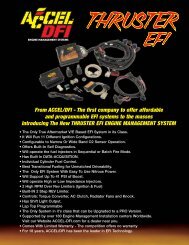Download Catalog - MagnaFuel
Download Catalog - MagnaFuel
Download Catalog - MagnaFuel
Create successful ePaper yourself
Turn your PDF publications into a flip-book with our unique Google optimized e-Paper software.
TIPS<br />
close attention to stainless steel lines.<br />
Voltage Step-down Devices: Never<br />
use step-down devices (voltage reduction<br />
boxes) on <strong>MagnaFuel</strong> fuel pumps. Never<br />
operate any electric motor on lower<br />
voltage than the motor was designed for.<br />
Low voltage can cause motor fluctuation<br />
and excessive amp draw. <strong>MagnaFuel</strong><br />
recommends 12.5V and higher<br />
Gauges: Gauges are tuning tools only,<br />
and should be removed from vehicle<br />
during racing conditions.<br />
Air in System: Any air going into fuel<br />
pump on the intake side causes the fuel<br />
to foam. Foam will create fluctuation<br />
in regulated pressure, oscillation in the<br />
pump motor and lean air/fuel mixture.<br />
Poor seals on the inlet side fittings, poor<br />
placement of the fuel pickup and/or return<br />
lines can cause this problem. Return line<br />
to fuel cell should be as far as possible<br />
from the pick up line fitting.<br />
Fuel Cell Vent Size: If the fuel cell vent<br />
is too small, it can cause excessive load<br />
and heat in the pump. You should run a<br />
minimum of a #8 vent for all applications.<br />
Questions and Answers<br />
Q. Why does my fuel pressure<br />
vary from one pass to the next<br />
A. Faulty fuel pressure gauge can cause<br />
fuel pressure fluctuation. If your gauge is<br />
a few years old, test it. Under-hood heat<br />
can affect gauge accuracy. Dirty regulator.<br />
Clean it or send it in. You should always<br />
set the regulator in a flowing condition.<br />
The engine should be running at about<br />
1,700 to 2,000 RPM. Battery low. Check<br />
voltage. Low pump pressure. Look for<br />
inlet line obstructions such as fuel-cell<br />
foam.<br />
Q. Why is my fuel pressure too<br />
low, or I have no pump pressure<br />
A. Check the voltage to the pump, relay<br />
switch. Could be faulty. They can be bad<br />
without going out. Weak relay reduces<br />
voltage. Replace them. Check wiring, look<br />
for an improper ground. Check the battery<br />
voltage. Check the filter and inlet line<br />
for obstructions. Look for leaks on inlet<br />
side. Adjust bypass. Is there debris in<br />
pump bypass (poppet). The bypass valve<br />
could be stuck open. Clean filter. Replace<br />
deteriorated fuel-cell foam. If no pressure,<br />
the pump may be operating in reverse.<br />
Check the wiring diagram. No fuel in fuel<br />
cell, or fuel cell improperly vented.<br />
Q. Why is my fuel pressure too<br />
high<br />
A. The return line could be too small.<br />
The voltage could be too high. If you need<br />
to run the pump at a pressure lower than<br />
it is designed for, call us and we’ll send<br />
you a special spring. Improperly adjusted<br />
bypass. See pump instruction sheet for<br />
proper setting.<br />
Q.Why won’t my pump run at<br />
all<br />
A. This is most likely a low- or novoltage<br />
problem. Check battery condition.<br />
Check for a bad fuse or bad relay. Look<br />
for improper ground. Check diagram,<br />
make sure you have wired everything<br />
correctly. Check any in-line switches for<br />
proper operation and voltage rating.<br />
Q. Why does my pump seem<br />
excessively hot<br />
A. Note that normal operating<br />
temperature can reach 137 degrees<br />
Fahrenheit. Anything below this is OK.<br />
If the pump is warmer than this, look for<br />
low voltage. If there is excessive pressure,<br />
there could be debris in pumping<br />
mechanism causing too much load. Check<br />
to see if the bypass is obstructed. Check<br />
instructions for proper pressure setting.<br />
Q. What could cause my pump<br />
to operate noisier than usual<br />
A. Aeration, or air in the system, can<br />
cause excessive noise. Check for poor<br />
inlet side sealing, check O-rings, fittings,<br />
damaged sealing angles on fittings. We<br />
recommend rubber isolator between<br />
pump and frame mounting surfaces.<br />
Mounting the pump solid to the frame of<br />
the vehicle can accentuate the noise. If<br />
the fluid level in the tank/cell is too low, the<br />
pump can suck a vortex and induce air<br />
into the system. Check pump mounting<br />
brackets for tightness. If the fuel cell<br />
return line dumps fuel near the suction<br />
line, it can cause air to enter the system<br />
also. Keep this return line’s fuel input as<br />
far away from the supply line as possible.<br />
Q. What can I do about a leaky<br />
pump<br />
A. Leaks are almost always caused<br />
by a worn or damaged pump seal. You<br />
need a new one. Return to factory. Seal<br />
should be replaced every two years under<br />
heavy use or if it sets unused for a long<br />
time. Return pump to factory for service.<br />
If pump leaks from vent hole, you need<br />
a new seal. Return pump to factory for<br />
service and bench flow testing.<br />
Q. Why does my regulator’s<br />
pressure fluctuate<br />
A. <strong>MagnaFuel</strong> considers excessive<br />
fluctuation to be over 1-1/2 pounds<br />
of pressure. Vibration, aeration, faulty<br />
gauges, or sharp changes in supply/pump<br />
pressure usually cause this. You should<br />
isolate the regulator with rubber mounting<br />
to tame vibration.<br />
Q. Why am I getting pressure<br />
spikes<br />
A. Poor gauges, too high or too low<br />
pump pressure, or sharp drops in system<br />
pressure could cause large pressure<br />
spikes at the regulator.<br />
Q. Why does my fuel system<br />
pressure seem to drop throughout<br />
the day<br />
A. Heat can effect liquid-filled gauges.<br />
Voltage drop can also cause this problem<br />
(battery, ground, connections, and<br />
incorrect wire gauge. Avoid mounting fuel<br />
system close to heat sources.<br />
Q. Why does my car seem to<br />
slow halfway through a quartermile<br />
run<br />
A. Not enough fuel volume. If it falls off<br />
in high gear, it is a pump volume issue;<br />
pump may be too small. If it falls down<br />
during launch, it is a fuel-pressure issue.<br />
Q. Why does my regulated pressure<br />
seem to creep higher and<br />
higher or go to full pump pressure<br />
A. Debris in fuel system has<br />
contaminated the valve-to-seat seal.<br />
Disassemble per regulator exploded<br />
view. Wash with brake cleaner or similar<br />
cleaner and reassemble. Be sure you<br />
reassemble correctly. CAUTION: Do not<br />
over-tighten cartridge. Check fuel filter.<br />
Make sure to flush lines before using a<br />
newly installed fuel system. A common<br />
problem of new systems when there is<br />
debris left over from cutting fuel lines and<br />
other installation trash.<br />
Q. Why is my regulator noisy<br />
when I first start the engine<br />
A. Vibration or chatter is common<br />
when then engine is first started due to<br />
air in system. This is amplified due to<br />
the metal-to-metal valve/seat assembly.<br />
Should go away in less than a minute.<br />
Regulators used for Nitrous are “deadheaded”<br />
to the solenoid. <strong>MagnaFuel</strong><br />
suggests you use an air-bleed system to<br />
purge trapped air from the system.<br />
INFORMATION<br />
Tech line (719) 532-1897 www. .com 31


